Cómo Bailar Flamenco
How To Dance Flamenco
by Eve Costarelli

Se coje la manzana
Se muerde the manzana
Se tira la manzana
Se pisa la manzana

You fetch the apple
You bite the apple
You throw down the apple
You step on the apple
I am a flamenco dancer. Through this dance, I am united with the gypsies of Southern Spain. These people, originated in Northern India and later, 500 years later, became the Spanish gypsies. These gypsies cultivated the seeds of music, dance and expression from their travels and integrated them into their own way of life. In Andalucía, they met and joined with the Spaniards, the Moors and the Sephardic Jews. After the reconquest, when Queen Isabella I of Castile and King Ferdinand II of Aragon wrested control of Spain from the Moors, there was mighty oppression against anyone who was not pure of Spanish blood. The gypsies had it even harder, as it was decreed that they could not live as gypsies either. From their hardships and their suffering, arose the art of flamenco. Gypsies live life in the present moment, yet always with deep rooted ties to the past and flamenco is the personification of this expression, of this connection to the moment, the awaking of the senses, the release of the authentic self.

The art of flamenco is a unity of body, mind and spirit connecting the artist to the history that binds it. The history of flamenco’s creation is also the history of the gypsies.
Flamenco can have a positive effect on the whole child:
- Stimulates the whole child.
- Reduces Stress.
- Develops coordination.
- Bolsters confidence.
- Cultivates community.
- Supports Diversity.
One of the basic pillars of dance education is to teach the whole child by using movement and expression as access points for a healthy, safe, engaging, supportive, and challenging environment. This is infused into the dance through the outlook of the teacher, the process of teaching and the content made available. This type of learning exposes children to the creation of art forms, cultivates self-expression (whether of an individual or a collection of people and peoples) and demonstrates cultures successfully mixing with each other—which are relevant lessons for children in today’s society.
A Little History of Flamenco

The Gypsies, a group of people including metal workers, animal trainers and entertainers, left Northern India and traveled through Arabia, Egypt, Tunisia, Algeria and Morocco, crossed the Straits of Gibraltar around 1425 and arrived on the shores of Andalucía, southern Spain, which is known to be the birth place of flamenco.
In Andalucía, the gypsies formed community with the people who lived there: the Sephardic Jews, the Moors and the Spaniards. They mixed freely among this veritable melting pot of cultures and absorbed the diverse melodies and rhythms around them: the music of the Moors, the songs of the Sephardic Jews and the dances of the Spaniards and then combined these with their own cultural traditions and transformed this multicultural mix of artistic and cultural flavors into the art of flamenco; the expression of the gypsies connection to the land through song, music and dance.
From the wailing of the blacksmith as his hammer lands on the anvil, knuckles rapping on a table and the cries from within the jails, songs arose with themes of death, anguish, despair and religious misgivings. These are the deep rooted beginnings of flamenco. When Spain became involved with the New World and merchant ships traveled from Spain to South America and Cuba and back again, lighter styles were introduced with themes of love, the countryside and la alegría de vivir, the love of life! Flamenco incorporates more than 50 different styles, known as palos, each with their own flavor and compás, rhythmic structure.
This confidence building, dynamic art form involves creative expression of one’s self within a strict framework of the rhythm, form and technique and is characterized by hand clapping palmas, finger snapping pitos, percussive footwork zapateado, and intricate hand floreo, arm braseo and body movements cuerpo. All flamenco artists must have the groove soniquete and the spirit of a flamenco artist duende. With arms and head held high, eyes downcast, chest lifted proudly, waist off the hips and the knees, slightly bent, to allow for the grace and poise to cross the floor. Always in rhythm; always in style; always aware of the emotional output of the song.
Flamenco embraces ALL: abilities, body types, ages! It captivates the attention and challenges the body, mind and emotional intelligence to connect. Flamenco can be done standing up or sitting down, with limbs that move and limbs that don’t, with the very young and the very old and with the small and the large. Flamenco can reach every/body as it is not solely reliant on the physical form, but includes stimulation of all of the senses, to bring the dance into the body, mind and spirit. With its electric energy, the fierce rhythms, soulful guitars and its smoldering passion, flamenco has the power to draw people in, ready to strike a pose, stomp their feet and shout ¡Olé!
Today, you can go all over the world and experience flamenco. It has truly become a multicultural art form, appealing to men, women and children of all ages, backgrounds and abilities. What is important to realize is that flamenco does not stand isolated in an era. This highly personal creative expression has become a highly polished art form with countless lovers of flamenco aficionados worldwide. Flamenco has a past, a present and a future. Flamenco is a journey that never ends, like the wandering of the gypsies.
Elements of Flamenco
Clapping Palmas

Fuertes/ Sordas
Palmas or clapping is a percussive instrument used to accompany flamenco song and dance. The clapping accentuates the important beats of the music in each rhythm.
- Strong Claps Palmas Fuertes create a crisp, loud sound achieved by hitting the flattened fingers of the one hand onto the palm of the other. This style is used to build excitement and to accompany footwork. (shown on the left)
- Muted Claps Palmas Sordas create a hollow, muffled sound achieved by cupping the palms and are used to emphasize the compás while accompanying a guitarist and singer in quiet passages. (shown on the right)
- Other instruments or rhythm items can be introduced at this time, such as, castanets, wood blocks with mallets, rapping knuckles or open palm on a flat surface, egg shakers, drums, tapping/stepping/stamping feet, an aide can be assisting by taping the body or the flat surface or by using one of the instruments.
Footwork Zapateado


Golpe: Full Foot Stamp
Planta: Ball of the foot
Tacon: heel strike
Flamenco Heart & Soul Duende

Duende is the heart and soul of flamenco. It is the inner spirit, which is released as a result of intense emotional involvement with the music, song and dance. It empowerment and inner stability, a force that takes over moves art to a more spiritual level.
Shouts of Encouragement Jaleo
Jaleo is a voiced expression that is used to express enthusiasm.
Olé! (can add a name) Bravo! Hooray!
Eso é! That’s it!
Toma que toma! Take it! Take it!
Vamo’ ya! Let’s go!
Additional Information:
Flamenco Books for Young Readers and To Read Aloud:
-
All About Flamenco/Todos Sobre Flamenco by Silvia Oivo
- Aunt Elaine Does The Dance From Spain by Leah Komaiko
- Bird With The Heart Of A Mountain by Barbara Mariconda
- Diseña Tu Vestido De Flamenco by Azucena Huidobro
- Flamenco Fantasy by Cynthia Ventrola Struven
- Lola’s Fandango by Ann Witte
- Mo Baila Flamenco by Fresia Barrientos Morales
- ¡Olé! Flamenco by George Ancona
- Perlie and The Flamenco Fairy by Wendy Harmer
- Quiero Bailar Flamenco by Azucena Huidobro
- Spain by Susie Brooks
- Spain: The Culture by Noa Lior
- Thea Stilton and The Spanish Dance Mission by Thea Stilton
- Today I Am A Dancer by Marisa Polansky
- With Love From Spain by Carol Weston
Flamenco Books for more advanced readers:
- Carmen: A Gypsy Geography by Ninotchka Devorah Bennahum
- Flamenco-All You Ever Wanted To Know by Emma Martinez
- ¡Flamenco! by Ken Haas & Gwynne Edwards
- The Art of Flamenco by D.E. Pohren
Flamenco Movies by Carlos Saura:
- Bodas De Sangre/Blood Wedding
- Carmen
- El Amour Brujo
- Flamenco
- Flamenco Flamenco
- Sevillanas
Gypsy Movies:
- Gypsy Heart by Jocelyn Ajami
- Queen of The Gypsies by Jocelyn Ajami
- Latcho Drom by Tony Gatlif
Music:
- Africa (Alegrías) by Tomasito
- Al Jardín de la Alegría (Alegrías y Cantiñas De Pinini) by Son de la Frontera
- A Mi Hijo Janatán (Minera) by El Viejín
- Andando Por Los Caminos (Rumba) by El Potito
- Bulería Aire by Parrilla de Jerez
- Bulería Menor by Son De La Frontera
- Costaleros de Triana (Sevillanas) by El Paali
- De Buen Aire (Bulerías de Jerez) by Miguel Poveda
- En El Palacio Del Sultan (Zambra-Tangos) by Juan Martin
- La Liebre (Sevillanas) by Corraeras De Lebrija
- Que Bonita Está Triana (Tangos) by Melchora Ortega
- ¡Qué de Faluta! (Soleares) By Jorge Pardo
- Rosa Maria (Tango) by El Camerón De La Isla
- Sentao En Mi Viejo Petate (Martinete) by El Capullo De Jerez
- Suite Bajarse Al More by Pata Negra
- Tangos de Mi Novia by Son de la Frontera
- Tiferet (Tangos) by Juanito Pascual
- Triana, Puente y Aparte (Tangos de Triana) by Miguel Poveda
- Villancicos De Gloria by La Macanita, Peña Tío José de Paula
- Yerbaguena-Oriente (Rumba) by Pepe Habichuela & The Bollywood Strings
Remember to “Always Be Dancing Flamenco”
*All rights to this guide belong to Eve Costarelli
NOTICE: You DO NOT Have the Right to Reprint or Resell this Activity Guide! You Also MAY NOT Give Away, Sell, or Share the Content Herein. Copyright @Always Be Dancing Expressive Movement 2017/2018 ALL RIGHTS RESERVED.
No part of this report may be reproduced or transmitted in any form whatsoever, electronic, or mechanical, including photocopying, recording, or by any informational storage or retrieval system without express written, dated and signed permission from the author.
DISCLAIMER AND/OR LEGAL NOTICES: The information presented in this report represents the views of the publisher as of the date of publication. The publisher reserves the rights to alter and update their opinions based on new conditions. This report is for informational purposes only. The authors and the publisher do not accept any responsibilities for any liabilities resulting from the use of this information. While every attempt has been made to verify the information provided here, the authors and the publisher cannot assume any responsibility for errors, inaccuracies or omissions. Any similarities with people or facts are unintentional.
AFFILIATE DISCLAIMER: Always Be Dancing Expressive Movement never recommends any service or product solely for the reason of receiving commissions.





